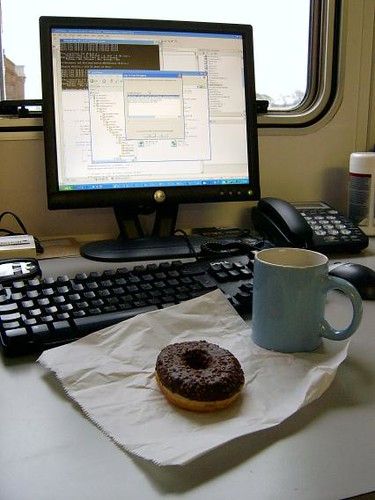
I’ve only started doing this blogging bit for a short while, after a few fitful starts. It’s hear because I need a research notebook, and I’m feeling good about making my inscriptions public (if you count the handful of people who skim this a public, why not?).
So, I’m catching up on lots of conversations that have happened amongst a larger oftentimes brilliant networked public that are relevant to my research vectors and (::eek::) a book. To wit, Tom Coates handy, pocket definition of Social Software:
Social Software can be loosely defined as software which supports, extends, or derives added value from, human social behaviour – message-boards, musical taste-sharing, photo-sharing, instant messaging, mailing lists, social networking.
Being transplanted into the land of script writers, I also like Ben Cerveny’s Hollywood-style “log line” style definition:
Social Software will be social software when we stop calling it social software.
I can grok this because it implies something valuable, and i’ll make that explicit as a kind of imbrication of Tom and Ben’s thoughts: social software is an instrumentality that creates, maintains and knits together social formations and social practice.
There are new things about social software, because it gets made newly by people hard at work writing code, creating designs, having “ah hah!” moments, or chats (after a few pints) that start with, “ooh! wouldn’t it be cool if..” This is the newness — that we can now articulate our social networks through..a network that supports one of the canonical, exemplar social practices par excellance — the circulation of culture. I can circulate my thoughts, through words, images, packaged videos and pictures expressing where I am, what I find funny or tragic, “bundles” of linkages to other cultural inscriptions — blog posts, news articles, reference resources on technical minutiae, etc.
This, I believe, is what Tom is saying.
What Ben adds, in my mind, or what I learn from him in this context, is two things.
One is that talking about the thing too much, in a very Lacanian sort of way, diminishes the work of making the thing. “Social Software” the meme can become its own undoing. We fetishize it as if it is the thing, pay too much attention and everything starts to look like it either is Social Software, or could be described in a PowerPoint as Social Software, and pretty much it’s efficacy as a way to create, maintain, knit together social formations is diminished because not everything that is described as such does that effectively. (I may be wrong..this is a sketchblog..)
Secondly, if you’re going to call something social software, then you’re either going to risk privileging software as an instrumentality over the social practice that that instrumentality facilitates. Software itself, as any good Latourian will describe, is itself a social-practice-derived activity. It lives and breathes as a particular kind of articulation of a specific network of design agents, sometimes called hackers, computer scientists, tinkerers, coders, code jockey, etc (the particular name the design agents assume or are laminated with, matters, of course, for the richest understanding of their activities.)
Maybe you won’t risk privileging the software over social practice, but unless the software is opened-up and seen as a social practice itself, it’s very easy to sort of lazily assume the instrumentality of “the software” as if it were what it is often assumed to be — a shrink-wrapped thing with no embedded sociality. But, then, of course, think about the swirl of social-action that engulfs using the software — calls to help desks; being part of a network of other social agents who use the software, discuss extended features, communicate problems or bugs amongst each other; finding new ways to use it in discussion groups — the networked public sociability of software is incredibly rich and vibrant, particularly around high-valenace assemblages like, for instance, the Google Maps API or Macromedia/Adobe’s Flash software.
Software, is social. So if it is always already social what’s the meaning of social software? Isn’t that redundant?
Well, of course it isn’t, exactly. But I guess where that’s I get a small allergic reaction to calling social software, social software. Software is always social — any endeavor partaken by social beings is, you know..social. Social software is then..what?
Social Softwares are things that allow me to maintain the network of people that matter amongst particular aspects of my lives (professional, personal, both, family, home, etc.) through the circulation of social semantics — communication, establishing dialogues and conversations, sharing cultures, disseminating meaning, the whole thing.
I guess now I’m saying that the reason we say “social software” is to place an emphasis on software that is specifically about creating this great, big network-based articulation of social formations, distinct from the social activities that take place by virtue of the fact that software, in its construction, is social; and distinct from the mobilization of social groups around software by virtue of the fact that software, in its use, is social.
Technorati Tags: social networks, social software
